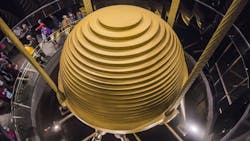Next-Gen Seismic Design: How Smart Tech Is Reinventing Earthquake-Resistant Buildings
Key Takeaways:
- Seismic design has entered a new era, blending traditional architectural practices with cutting-edge technology such as AI modeling, IoT sensors, and advanced damping systems.
- Novel materials like shape-memory alloys (SMAs) improve resilience by absorbing energy and returning to original forms after deformation.
- AI-powered design platforms simulate seismic conditions and optimize structural resilience in real-time, enabling faster, more accurate planning.
- IoT monitoring provides real-time data on ground motion and building health, enabling automated responses such as gas shutoff, alerts, and post-quake structural assessments.
Natural disasters are among the most persistent challenges building and architectural firms must manage. Unlike many other risks, these situations are unavoidable, regardless of how much care teams take in planning and construction. Mitigation is the only way forward, so seismic design is a critical piece of building safety in earthquake-prone regions.
Earthquake-resistant design is a centuries-old practice, as architects have had to deal with tremors as long as they’ve built in areas of seismic activity. While some of the fundamental philosophies remain the same, the field has evolved with new technologies and research. Capitalizing on these innovations is key to ensuring a structure can last well into the future.
Damping
Shock-absorbing dampers are one of the most popular seismic design practices today. While damping can take several forms, the core concept remains consistent between all of them. By transferring motion, structures like pistons and counterweights can minimize the felt effect of an earthquake on a building.
Taipei 101 is the most famous example of this technology in action. The skyscraper was recently able to withstand Taiwan’s strongest earthquake in 25 years because of its 660-ton mass damper. The massive counterweight moves in the opposite direction of a swaying building to minimize leaning and matches its vibration frequency to absorb and dissipate mechanical stress.
Other structures use a series of smaller dampers throughout the property instead of one large one. Placing shock absorbers near load-bearing supports on each floor is a common approach.
Seismic Cloaking
Seismic cloaks are a similar but more advanced method. The underlying principle of absorbing and dispersing vibration is the same, but instead of doing so within a building, seismic cloaking channels motion away from the area to cancel out the earthquake.
These setups work either by inserting large tubes filled with materials like water or gas into the ground before a building or surrounding an area with underground elastic rings. In either case, the “cloak” vibrates before seismic waves reach a foundation. The resulting dissipation from this motion is enough to alleviate the intensity of the quake before it causes any damage.
Installing a seismic cloak is a larger, more complicated undertaking than other engineering methods. However, it may also be one of the most effective strategies, as it dramatically reduces a tremor’s power before waves even reach a structure.
Flexible Foundations
A more site-specific approach to seismic design is to provide flexibility in a building’s foundation. Placing flexible supports under the base can minimize vibrations by counteracting the motion of the ground, like how tuned dampers counterbalance movement within a tower.
The concept is similar to how ball bearings work in drawer slides. Because bearings reduce friction between moving parts, they enable sliding motions without straining the rigid mechanical components around them. Placing similar moving structures at the top and bottom of pillars underneath a foundation helps these supports angle so that the base glides laterally in the opposite direction of the seismic waves.
In such a setup, only the underground pillars and their bearings move in a quake. Unlike rigid infrastructure, though, this motion does not interfere with its integrity, and the countermotion ensures the building above remains in place.
Novel Materials
Structural optimizations like these are important, but material considerations also play into seismic design. Conventional construction resources often provide strength through rigidity, but this becomes their downfall in times of intense vibration. Novel, more flexible materials can absorb earthquake vibration rather than resist it to the point of breaking.
Shape-memory alloys (SMAs) are especially noteworthy. As the name implies, an SMA “remembers” its original shape, so it can reform back into its desired structure after deforming from external pressure. Consequently, SMAs can either dissipate the impact of a quake by moving in response to vibration or minimize the damage of one by ensuring load-bearing structures can reform after taking damage.
Some SMA-based structures exhibit 46% less shear strain and 31% greater energy absorption than conventional alternatives. Those are impressive figures, but the real-world results vary by application and the material in question. It may take further research and development to discover which resources are best for which use cases.
AI-Assisted Seismic Design
Artificial intelligence (AI) can be useful in earthquake-resistant design, too. With so many options available for architects to mitigate the impact of natural disasters, the optimal path forward for a specific project is not always clear. AI can provide the needed clarity.
AI design tools can simulate digital models of a building to determine how it would perform in varying conditions. Because AI is both fast and accurate when analyzing vast amounts of data, these simulations can produce results in less time than manual means and with greater reliability.
Some AI-assisted design platforms may even provide suggestions to highlight how a design could be more earthquake-resistant. With such insight, architectural firms can determine the best solutions for their unique projects without costly real-world trial and error.
IoT Monitoring
The Internet of Things (IoT) is another tech-driven solution to improve seismic design. While IoT devices may be unable to disrupt vibrations or counteract motion, they can provide early warnings and insights to inform effective responses.
Force torque sensors can indicate infrastructure’s structural health, informing residents or responders if a building is safe after an earthquake. These same IoT sensors can alert nearby people of the need to evacuate if necessary and monitor ground conditions to let them know when it’s safe to do so.
Alternatively, IoT endpoints in the ground can detect incoming seismic activity before it hits an area. Gas and water lines could automatically cut off in response to prevent flooding or combustion risks if utility systems experience damage during the tremor. Over time, data from these devices could also indicate which areas need better earthquake protection or which show the least wear, suggesting optimal solutions.
Seismic Design Is Evolving
The need for earthquake-resistant architecture will never go away. As populations grow and urban areas expand, these considerations become all the more crucial. Building professionals must learn how to manage such events to protect people in the future.
New technologies and research have led to more reliable seismic design options than ever before. Continuing to invest in and develop these innovations will pave the way for a safer tomorrow.
Next Steps for Building Owners and Smart Building Tech Integrators
- Assess Existing Seismic Resilience: Conduct structural audits to evaluate how well current facilities would perform in a seismic event. Focus on older buildings not designed to modern standards.
- Incorporate AI into the Design Phase: Use AI-assisted design tools to simulate earthquake scenarios and test design alternatives before construction begins.
- Retrofit with Smart Dampers and Flexible Supports: Identify opportunities to install or upgrade damping systems and foundation technologies in vulnerable buildings.
- Invest in IoT Infrastructure: Deploy seismic IoT sensors for real-time monitoring, automated alerts, and data collection for long-term risk mitigation.
- Stay Informed on Material Science Advances: Monitor developments in shape-memory alloys and other high-performance materials to plan smarter renovations and new builds.
- Evaluate Seismic Cloaking for Critical Assets: Though complex and currently costly, seismic cloaking may be a strategic long-term investment for mission-critical facilities like hospitals or data centers.
- Collaborate with Structural and Tech Partners: Work with engineering firms and smart tech vendors who are innovating at the intersection of architecture and seismic resilience.
About the Author

Emily Newton
Emily Newton is an industrial and tech journalist passionate about how technology is revolutionizing each sector. She has been writing and editing professionally for more than five years and is the editor-in-chief of Revolutionized.
